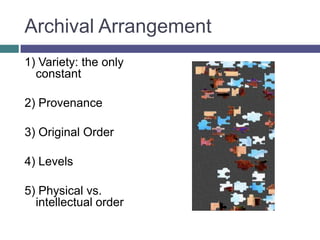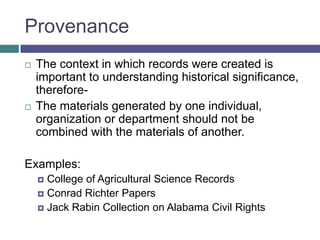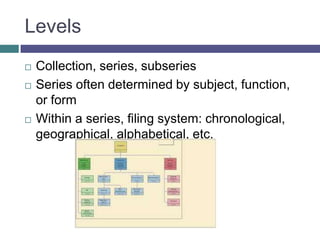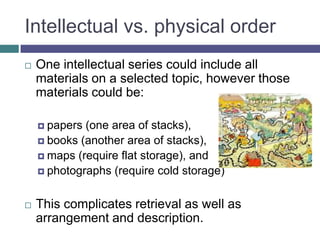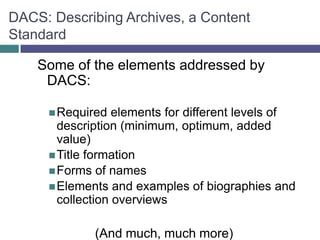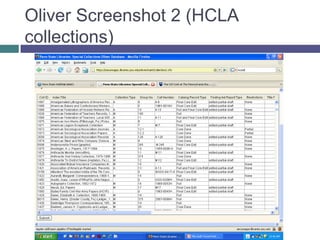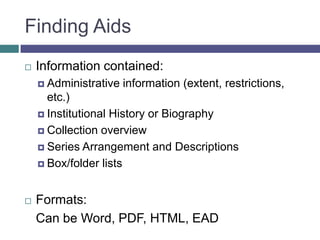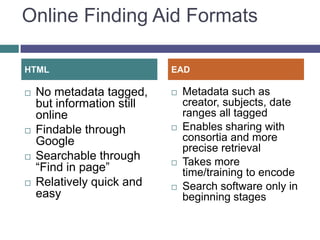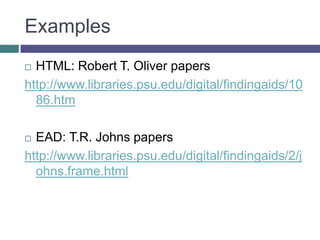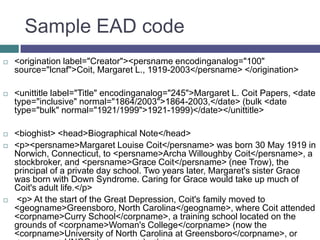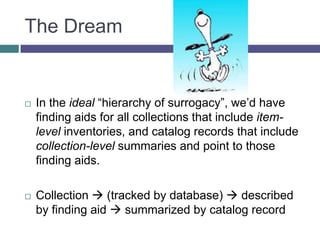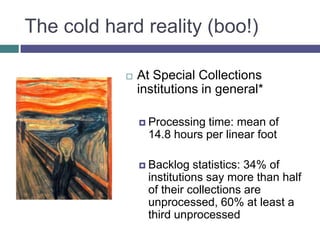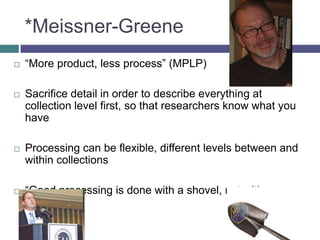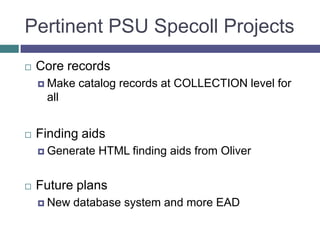Archival Processing And Description
- 1. Archival Processing and Description(Practices, Dreams, Realities, Projects)
- 2. Library vs. Archives MaterialsSecondary sourcesSelf-conscious creationsItems collected and classified at individual levelItems described according to well-established standardsPrimary sourcesCreated in course of business/lifeItems collected and classified in aggregate Description standards only recently establishedLibrary (ŌĆ£neatŌĆØ) Archives (ŌĆ£messyŌĆØ)
- 4. Archival FunctionsAppraiseAcquireArrangeDescribePreserveMake accessible[For this presentation, we are concentrating on arrangement and description]
- 5. Archival Arrangement1) Variety: the only constant2) Provenance3) Original Order4) Levels5) Physical vs. intellectual order
- 6. Variety is the spice of archival lifeCollections vary greatly in size, format and complexity.
- 7. ProvenanceThe context in which records were created is important to understanding historical significance, therefore-The materials generated by one individual, organization or department should not be combined with the materials of another. Examples:College of Agricultural Science RecordsConrad Richter PapersJack Rabin Collection on Alabama Civil Rights
- 8. Original OrderImportant in theory, but often violated in practiceMaterials should be kept in the order in which they were originally created, maintained or used.However, materials often come to us in no usable order.
- 9. LevelsCollection, series, subseriesSeries often determined by subject, function, or formWithin a series, filing system: chronological, geographical, alphabetical, etc.
- 10. Intellectual vs. physical orderOne intellectual series could include all materials on a selected topic, however those materials could be:papers (one area of stacks), books (another area of stacks), maps (require flat storage), and photographs (require cold storage)This complicates retrieval as well as arrangement and description.
- 11. Describe1) Standards ŌĆō DACS2) Methods-Database trackingFinding aids Catalog records
- 12. DACS: Describing Archives, a Content StandardSome of the elements addressed by DACS:Required elements for different levels of description (minimum, optimum, added value)Title formationForms of namesElements and examples of biographies and collection overviews(And much, much more)
- 13. Database tracking (Oliver homepage)
- 14. Oliver Screenshot 2 (HCLA collections)
- 15. Oliver Screenshot 3 (collection-items)
- 16. Finding AidsInformation contained:Administrative information (extent, restrictions, etc.)Institutional History or BiographyCollection overviewSeries Arrangement and DescriptionsBox/folder listsFormats: Can be Word, PDF, HTML, EAD
- 17. Online Finding Aid FormatsNo metadata tagged, but information still online Findable through GoogleSearchable through ŌĆ£Find in pageŌĆØRelatively quick and easyMetadata such as creator, subjects, date ranges all taggedEnables sharing with consortia and more precise retrievalTakes more time/training to encodeSearch software only in beginning stagesHTML EAD
- 18. ExamplesHTML: Robert T. Oliver papershttp://www.libraries.psu.edu/digital/findingaids/1086.htmEAD: T.R. Johns papershttp://www.libraries.psu.edu/digital/findingaids/2/johns.frame.html
- 19. Robert T. Oliver Papers Finding Aid Screenshot
- 20. T.R. Johns Papers Finding Aid Screenshot
- 21. Sample EAD code<origination label="Creator"><persnameencodinganalog="100" source="lcnaf">Coit, Margaret L., 1919-2003</persname> </origination> <unittitle label="Title" encodinganalog="245">Margaret L. Coit Papers, <date type="inclusive" normal="1864/2003">1864-2003,</date> (bulk <date type="bulk" normal="1921/1999">1921-1999)</date></unittitle> <bioghist> <head>Biographical Note</head> <p><persname>Margaret Louise Coit</persname> was born 30 May 1919 in Norwich, Connecticut, to <persname>Archa Willoughby Coit</persname>, a stockbroker, and <persname>Grace Coit</persname> (nee Trow), the principal of a private day school. Two years later, Margaret's sister Grace was born with Down Syndrome. Caring for Grace would take up much of Coit's adult life.</p> <p> At the start of the Great Depression, Coit's family moved to <geogname>Greensboro, North Carolina</geogname>, where Coit attended <corpname>Curry School</corpname>, a training school located on the grounds of <corpname>Woman's College</corpname> (now the <corpname>University of North Carolina at Greensboro</corpname>, or <corpname>UNCG</corpname>). </p>
- 22. Catalog records
- 23. The DreamIn the ideal ŌĆ£hierarchy of surrogacyŌĆØ, weŌĆÖd have finding aids for all collections that include item-level inventories, and catalog records that include collection-level summaries and point to those finding aids.Collection ’āĀ (tracked by database) ’āĀ described by finding aid ’āĀ summarized by catalog record
- 24. The cold hard reality (boo!)At Special Collections institutions in general*Processing time: mean of 14.8 hours per linear footBacklog statistics: 34% of institutions say more than half of their collections are unprocessed, 60% at least a third unprocessed
- 25. (Cold, hard reality continued)At PSU Special Collections:About 75% of our collections are in the CatAbout 30% of our collections have finding aidsAbout 25% of our collections have neither (ŌĆ£hidden collectionsŌĆØ)
- 26. *Meissner-GreeneŌĆ£More product, less processŌĆØ (MPLP)Sacrifice detail in order to describe everything at collection level first, so that researchers know what you haveProcessing can be flexible, different levels between and within collectionsŌĆ£Good processing is done with a shovel, not with tweezersŌĆØ
- 27. Pertinent PSU Specoll ProjectsCore recordsMake catalog records at COLLECTION level for allFinding aidsGenerate HTML finding aids from OliverFuture plansNew database system and more EAD


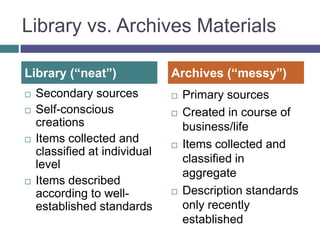
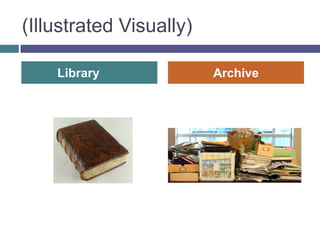
![Archival FunctionsAppraiseAcquireArrangeDescribePreserveMake accessible[For this presentation, we are concentrating on arrangement and description]](https://image.slidesharecdn.com/archivalprocessinganddescription-100217100245-phpapp02/85/Archival-Processing-And-Description-4-320.jpg)
